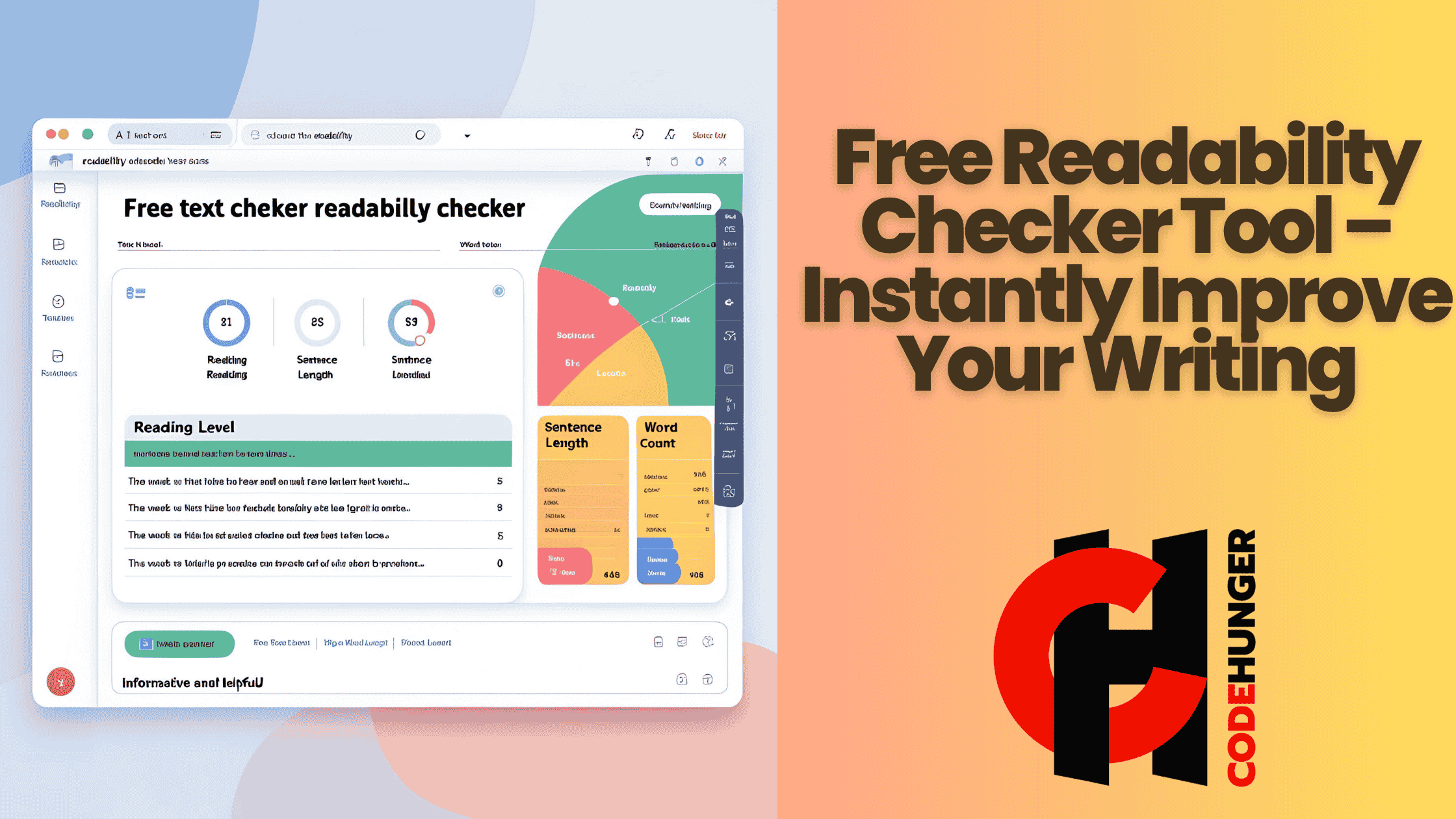Free Readability Checker Tool – Instantly Improve Your Writing
Let’s be honest—nobody enjoys reading something that feels like decoding a cryptic puzzle. Whether you're a content creator, marketer, student, or just someone who wants to be understood, writing in a clear and concise manner is critical. But how can you know if your writing is readable?
That’s where a Free Readability Checker Tool swoops in like a superhero for your sentences.
In this post, we'll dive deep into why readability matters, how you can analyze and improve your content using a readability checker, and why CodeHunger’s free tool is your best bet to make every word count.
What Is Readability and Why Should You Care?
Have you ever abandoned an article halfway because it was too complex or boring? That’s readability in action.
Understanding Readability
Readability refers to how easy it is for someone to read and understand a piece of text. It’s not just about grammar or vocabulary. It also includes sentence structure, tone, and how content flows from one point to another.
Why Readability Is Crucial
- Better Engagement: Simple content keeps readers interested longer.
- Higher Conversion: Clear writing leads to higher action rates—think purchases, sign-ups, or downloads.
- Improved SEO: Google loves content that’s easy to read and rewards it with better rankings.
- Accessibility: You widen your reach by making content digestible for readers at all literacy levels.
Meet CodeHunger’s Free Readability Checker Tool
With tons of tools online, you might wonder—why choose CodeHunger’s? Well, this isn’t just a generic checker. It’s tailored to deliver quick, accurate, and actionable results that writers love.
What It Does
- Analyzes text complexity in real-time
- Provides readability scores (Flesch-Kincaid, Gunning Fog, etc.)
- Highlights difficult words or complex sentences
- Gives improvement tips instantly
No Login, No Download – 100% Free and Instant
Just head to https://www.codehunger.in/free/content-readability-check-free, paste your text, and get your readability score immediately—no sign-up required.
How the Tool Works: A Closer Look at Readability Scores
To make improvements, you need to understand the metrics behind readability. Let’s break it down.
Popular Readability Metrics
- Flesch Reading Ease: Ranges from 0–100. Higher is easier. A score of 60–70 is easily understood by 13–15-year-olds.
- Flesch-Kincaid Grade Level: Tells you the U.S. school grade level needed to understand the text.
- Gunning Fog Index: Estimates years of education needed to comprehend the text.
- SMOG Index: Measures how many years of education a person needs to understand your writing.
Example: A product description scoring at a 12th-grade level may alienate customers looking for quick, simple information.
Why These Metrics Matter
If your blog post is at a college reading level, but your audience is general public, you’ve got a mismatch. These metrics help realign your tone and language with your target readers.
How to Improve Your Writing Using Readability Insights
Getting your score is the first step. Now, let's talk about how to actually use that data to refine your content.
1. Shorten Your Sentences
Long, winding sentences may look poetic, but they confuse readers. Break them up.
Before:
"The software, which was developed in a span of six months by an international team of developers, offers an unparalleled user experience."
After:
"The software was developed in six months by an international team. It offers an unparalleled user experience."
2. Use Simple Words
Swap complex vocabulary with easy, everyday words.
Instead of "utilize" → Say "use"
Instead of "commence" → Say "start"
3. Avoid Passive Voice
Passive voice often makes your writing sound vague or robotic.
Passive: The blog was written by John.
Active: John wrote the blog.
4. Organize With Headings and Bullets
This post? You’re reading it easily because it's structured with headings, subheadings, and bullet points—all readability power-ups.
How Readability Affects SEO and User Experience
Here’s where things get interesting. Readability isn’t just a “nice-to-have” for users—it directly impacts how well your content ranks on search engines.
Google’s Take on Readability
Google's algorithms reward content that is easy to read and well-structured. While readability isn’t an official ranking factor, it influences factors like:
- Time on Page
- Bounce Rate
- Dwell Time
And guess what? These are SEO ranking factors.
A study by Backlinko found that the average Google first-page result is written at a 9th-grade reading level.
Mobile Optimization
With more than 60% of users browsing on mobile, shorter paragraphs, simple sentences, and scannable formats become even more crucial.
Why CodeHunger’s Readability Checker Stands Out
There are a lot of readability tools out there—so why should you use CodeHunger’s free checker?
Lightning Fast & User Friendly
- No ads or distractions
- Real-time results
- Easy copy-paste function
Free Forever
Unlike tools that lock advanced features behind paywalls, CodeHunger’s tool gives you complete analysis—absolutely free.
Built with Developers in Mind
Developed by a team that also offers tools like Free Invoice Generator, CodeHunger understands what creators, freelancers, and businesses need in a writing tool.
Conclusion
In today’s content-saturated world, clarity is power. Whether you’re writing a blog, crafting a social media post, or putting together a product manual, how you say something matters just as much as what you say.
So if you want your words to resonate, connect, and convert—start with readability.
Try out the Free Readability Checker Tool by CodeHunger and make your content effortlessly impactful.









